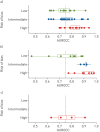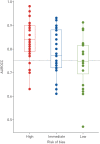Systematic review of diagnostic methods for acute respiratory distress syndrome
- PMID: 33532455
- PMCID: PMC7836439
- DOI: 10.1183/23120541.00504-2020
Systematic review of diagnostic methods for acute respiratory distress syndrome
Abstract
Rationale: Acute respiratory distress syndrome (ARDS) is currently diagnosed by the Berlin definition, which does not include a direct measure of pulmonary oedema, endothelial permeability or pulmonary inflammation. We hypothesised that biomarkers of these processes have good diagnostic accuracy for ARDS.
Methods: Medline and Scopus were searched for original diagnostic studies using minimally invasive testing. Primary outcome was the diagnostic accuracy per test and was categorised by control group. The methodological quality was assessed with QUADAS-2 tool. Biomarkers that had an area under the receiver operating characteristic curve (AUROCC) of >0.75 and were studied with minimal bias against an unselected control group were considered to be promising.
Results: Forty-four articles were included. The median AUROCC for all evaluated tests was 0.80 (25th to 75th percentile: 0.72-0.88). The type of control group influenced the diagnostic accuracy (p=0.0095). Higher risk of bias was associated with higher diagnostic accuracy (AUROCC 0.75 for low-bias, 0.77 for intermediate-bias and 0.84 for high-bias studies; p=0.0023). Club cell protein 16 and soluble receptor for advanced glycation end-products in plasma and two panels with biomarkers of oxidative stress in breath showed good diagnostic accuracy in low-bias studies that compared ARDS patients to an unselected intensive care unit (ICU) population.
Conclusion: This systematic review revealed only four diagnostic tests fulfilling stringent criteria for a promising biomarker in a low-bias setting. For implementation into the clinical setting, prospective studies in a general unselected ICU population with good methodological quality are needed.
Copyright ©ERS 2021.
Conflict of interest statement
Conflict of interest: L.A. Hagens has nothing to disclose. Conflict of interest: N.F.L. Heijnen has nothing to disclose. Conflict of interest: M.R. Smit has nothing to disclose. Conflict of interest: M.J. Schultz has nothing to disclose. Conflict of interest: D.C.J.J. Bergmans has nothing to disclose. Conflict of interest: R.M. Schnabel has nothing to disclose. Conflict of interest: L.D.J. Bos reports grants from the Dutch Lung Foundation (young investigator grant, public–private partnership grant and Dirkje Postma Award) outside the submitted work.
Figures



References
-
- Ranieri VM, Rubenfeld GD, Thompson BT, et al. . Acute respiratory distress syndrome: the Berlin definition. JAMA 2012; 307: 2526–2533. - PubMed
Publication types
LinkOut - more resources
Full Text Sources
